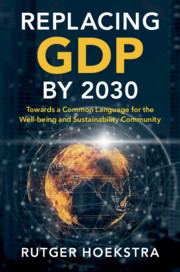Book contents
- Replacing GDP by 2030
- Advance Praise for Replacing GDP by 2030
- Replacing GDP by 2030
- Copyright page
- Dedication
- Contents
- Figures
- Tables
- Boxes
- Preface
- Acknowledgements
- Part I Why a New Strategy Is Needed
- Part II The New Strategy: A Community for Well-being and Sustainability
- 5 Outline of the Strategy
- 6 Global Environmental Accounts (GENA)
- 7 Global Societal Accounts (GSA)
- 8 Global Economic Accounts (GECA)
- 9 Global Distribution Accounts (GDA)
- 10 Global Quality Accounts (GQA) and Quality Indicators
- 11 Implementation of the Strategy
- Annex: Beyond-GDP Milestones and Measurement Systems
- Notes
- References
- Index
5 - Outline of the Strategy
from Part II - The New Strategy: A Community for Well-being and Sustainability
Published online by Cambridge University Press: 24 May 2019
- Replacing GDP by 2030
- Advance Praise for Replacing GDP by 2030
- Replacing GDP by 2030
- Copyright page
- Dedication
- Contents
- Figures
- Tables
- Boxes
- Preface
- Acknowledgements
- Part I Why a New Strategy Is Needed
- Part II The New Strategy: A Community for Well-being and Sustainability
- 5 Outline of the Strategy
- 6 Global Environmental Accounts (GENA)
- 7 Global Societal Accounts (GSA)
- 8 Global Economic Accounts (GECA)
- 9 Global Distribution Accounts (GDA)
- 10 Global Quality Accounts (GQA) and Quality Indicators
- 11 Implementation of the Strategy
- Annex: Beyond-GDP Milestones and Measurement Systems
- Notes
- References
- Index
Summary
The previous chapters have shown that there is one powerful community (“the GDP multinational") which is being challenged by a heterogeneous and weakly organised community (“the Beyond-GDP cottage industry). The ever-expanding range of Beyond-GDP initiatives will not lead to success however. A new strategy is based on the GDP success story and aims to create an institutionalised community with a clear goal and coherent structure based on a common language. The chapter argues that the community should not be based on the SDGs, green accounting or the SEEA. It also argues that the community should not be based on economic terminology and theory but rather on multidisciplinary building blocks such as stock/flow accounting, networks and limits. The aim of the community is to enhance well-being and sustainability and one of its most important features is its common language: the System of Global and National Accounts (SGNA). The SGNA has four system accounts (environment, society, economy and distribution), which describe how the systems are developing. However, this does not yet tell people whether the developments are good or bad. This is left to the quality accounts.
Keywords
Information
- Type
- Chapter
- Information
- Replacing GDP by 2030Towards a Common Language for the Well-being and Sustainability Community, pp. 105 - 125Publisher: Cambridge University PressPrint publication year: 2019
